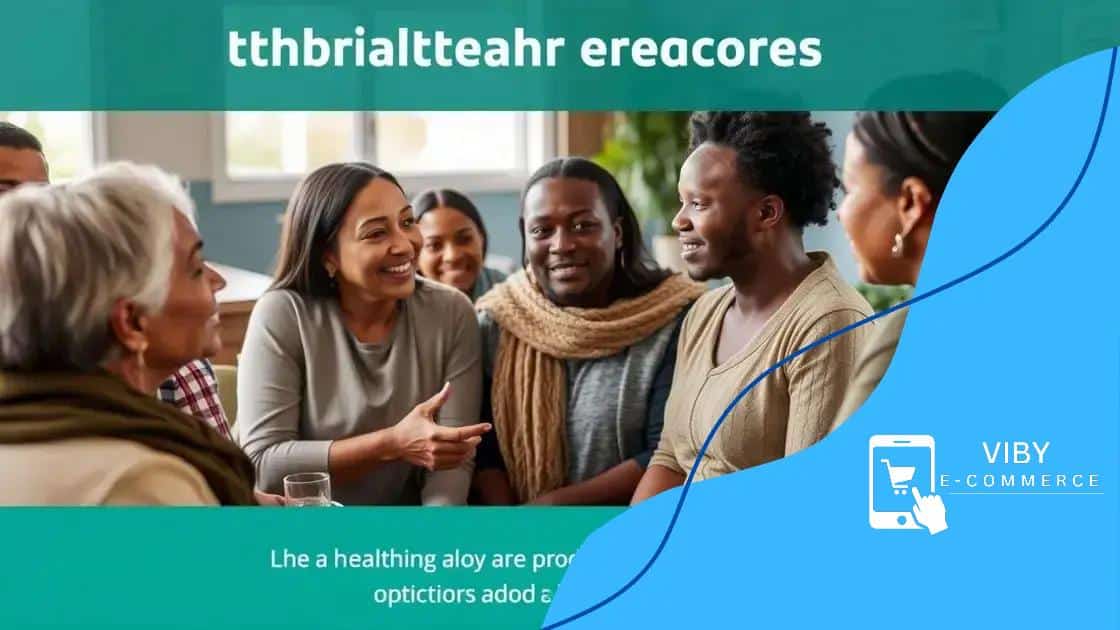The future of Medicaid expansion under new legislation

The future of Medicaid expansion offers improved healthcare access for low-income families through expanded eligibility, increased federal funding, and innovative services, while presenting challenges like enrollment complexity and financial limits.
The future of Medicaid expansion under new legislation poses crucial questions for those seeking healthcare coverage. This pivotal shift in policy may redefine access for millions. Are you prepared to navigate these changes?
Understanding Medicaid expansion
Understanding Medicaid expansion is vital in today’s healthcare debate. This initiative aims to provide health coverage to more individuals, primarily targeting low-income families. The expansion allows states to access federal funds to offer additional healthcare services.
What is Medicaid Expansion?
Medicaid expansion refers to the provisions set by the Affordable Care Act that enable states to broaden their Medicaid programs. This means that more low-income adults can qualify for coverage, even if they are without children. The government covers a significant portion of the costs, making it appealing for states.
Benefits of Medicaid Expansion
This program brings numerous benefits:
- Increased access to healthcare services for millions.
- Reduces uninsured rates, leading to better public health outcomes.
- Improves state economies through federal funding.
Many people believe that Medicaid expansion mainly helps those who lack coverage. However, it also supports families in maintaining their health. Numerous states that adopted this expansion have seen their insurance rates rise dramatically.
How Does It Work?
Medicaid is managed by individual states, and expansion allows states to increase eligibility criteria. For instance, individuals with incomes up to 138% of the federal poverty level may qualify. Those who were previously excluded, such as childless adults, can now receive assistance.
By understanding Medicaid expansion, it becomes clear how crucial it is for enhancing health opportunities and securing necessary services for vulnerable populations. Many questions remain about future legislation, making this an ever-evolving topic to follow.
Key changes in the new legislation
The key changes in the new legislation around Medicaid expansion are significant. These updates are designed to improve healthcare access, especially for low-income families. Understanding these changes is crucial for anyone affected by Medicaid.
Expanded Coverage
One of the major revisions is the expansion of eligibility criteria. Now, more adults can qualify for Medicaid based on their income levels. This change helps to cover some who previously fell through the cracks.
Increased Federal Funding
Another important aspect is the increase in federal funding for states that choose to expand Medicaid. This financial support reduces the burden on state budgets, encouraging more states to adopt the expansion. This makes it easier for governments to provide necessary healthcare services.
Moreover, with the new legislation, funding is also aimed at enhancing mental health services. Improving mental health resources is a crucial step in providing comprehensive healthcare. People often overlook the importance of mental health in overall well-being.
Technology Improvements
Legislation now includes provisions for technology upgrades within state Medicaid programs. This includes better data management systems to track patient care and outcomes. Such upgrades can help states serve their populations more effectively.
Additionally, the new rules aim to streamline the enrollment process. This means that applying for Medicaid will be easier and faster for eligible individuals, reducing barriers to access. By simplifying enrollment, more people can get the care they need promptly.
Overall, the key changes in the new legislation are a step forward in making healthcare more accessible. They aim to support vulnerable populations and improve overall health outcomes.
Impact on low-income communities

The impact on low-income communities due to changes in Medicaid expansion is profound. These communities often face significant barriers to healthcare, and the expansion aims to alleviate some of these challenges. By improving access to healthcare services, the expansion has the potential to transform lives.
Access to Essential Services
One of the most direct benefits is that low-income individuals will gain greater access to essential health services. This includes preventive care, mental health resources, and routine check-ups. Access to these services can prevent minor health issues from becoming severe.
Reduction in Emergency Room Visits
With better access to healthcare, we can expect a reduction in the number of unnecessary emergency room visits. When individuals have regular access to care, they can manage their health needs more proactively. This leads to healthier communities and less strain on the healthcare system.
- Improved health outcomes for chronic conditions.
- Enhanced mental health support for individuals.
- Lower healthcare costs for families and local governments.
Furthermore, addressing health needs can lead to increased productivity. Healthy individuals contribute more effectively to their communities and the workforce. This, in turn, can boost local economies and enhance overall quality of life.
Challenges That Remain
Despite these benefits, challenges still exist. Some low-income families may not be aware of their eligibility for Medicaid or might find the enrollment process complex. Educational programs become necessary to inform these communities about how to take advantage of the expansion.
In summary, the impact on low-income communities can create significant improvements in health and economic stability. By ensuring that everyone has access to healthcare, we can help build stronger, healthier communities.
Future challenges and opportunities
The future challenges and opportunities related to Medicaid expansion are significant as we look ahead. These changes aim to improve access to healthcare, but they also bring new issues to address. It’s essential to recognize both the obstacles and the potential benefits that lie in the future.
Challenges Ahead
One of the key challenges is funding. Though Medicaid expansion provides federal support, state budgets may still face pressure. States need to balance their budgets while improving healthcare services. This can lead to difficult decisions about resource allocation.
Enrollment Barriers
Another challenge is ensuring that eligible individuals are aware of their opportunities. Many may struggle to navigate the enrollment process. To address this, outreach programs must be developed to educate communities about their rights and options. It is crucial to simplify enrollment procedures, making it easier for people to access services.
- Financial limitations for state healthcare budgets.
- Awareness gaps among low-income individuals.
- Complex enrollment processes that deter individuals.
Additionally, as healthcare needs evolve, Medicaid programs will have to adapt. This includes addressing mental health, substance use disorders, and the needs of the aging population. Adapting to these changing needs requires flexibility and innovative approaches.
Opportunities for Growth
Despite the challenges, numerous opportunities exist. States can implement innovative healthcare models that emphasize preventive care and community-based solutions. By focusing on preventative measures, states can improve health outcomes and reduce long-term costs.
Moreover, the expansion can lead to workforce growth in the healthcare sector. More healthcare professionals will be needed to meet the rising demand for services. This can spur job creation and boost local economies.
Overall, addressing the future challenges and opportunities will require collaboration between policymakers, healthcare providers, and communities. By working together, we can maximize the benefits of Medicaid expansion while overcoming the obstacles that arise.
Navigating Medicaid options for families
Navigating Medicaid options for families can be challenging. Many families are unsure about what programs are available to them and how to apply. Understanding these options is crucial to securing the healthcare coverage needed.
Understanding Eligibility
The first step in navigating Medicaid is understanding eligibility criteria. Each state has its own rules concerning who qualifies for Medicaid services. Generally, low-income families, children, pregnant women, and individuals with disabilities can qualify. Families should check their state’s Medicaid website for specific details.
Types of Medicaid Programs
There are various Medicaid programs that cater to different needs:
- Medicaid for Children: Provides comprehensive health coverage for children, including regular check-ups and vaccinations.
- Medicaid for Pregnant Women: Covers prenatal care and labor, ensuring healthy pregnancies and births.
- Long-term Care Medicaid: For families whose members require significant health support over time.
Each of these programs plays a vital role in supporting families during different life stages and health needs. It is essential to identify which program suits your family’s needs best.
Enrollment Process
The enrollment process can seem overwhelming but is critical for accessing benefits. Families should gather necessary documents, such as income information and social security numbers. Many states offer online applications, which can simplify the process. Additionally, local health departments and non-profit organizations can provide assistance and guidance on completing applications.
To successfully navigate Medicaid options for families, it’s also useful to reach out to local advocacy groups that specialize in health care access. These organizations can offer resources and support for families facing obstacles.
In conclusion, understanding and navigating Medicaid options is essential for families. By knowing the eligibility requirements, available programs, and how to enroll, families can make informed decisions about their healthcare.
In summary, navigating Medicaid options is crucial for families seeking healthcare coverage. By understanding eligibility, available programs, and the enrollment process, families can access the services they need. The changes in legislation present both challenges and opportunities, but with the right information, families can make informed decisions. Reaching out for support can help simplify the journey to securing healthcare. Ultimately, ensuring that everyone has access to healthcare is essential for building healthier communities.
FAQ – Frequently Asked Questions About Navigating Medicaid Options for Families
What are the eligibility requirements for Medicaid?
Eligibility requirements vary by state, but generally low-income families, children, pregnant women, and individuals with disabilities qualify for Medicaid.
What types of programs does Medicaid offer?
Medicaid offers various programs, including coverage for children, pregnant women, and long-term care services for individuals with ongoing health needs.
How can I apply for Medicaid?
You can apply for Medicaid online through your state’s Medicaid website or via local health departments that provide assistance with the enrollment process.
Where can I find help navigating Medicaid options?
Local advocacy groups and community organizations often offer resources and assistance for families trying to understand and access Medicaid services.





